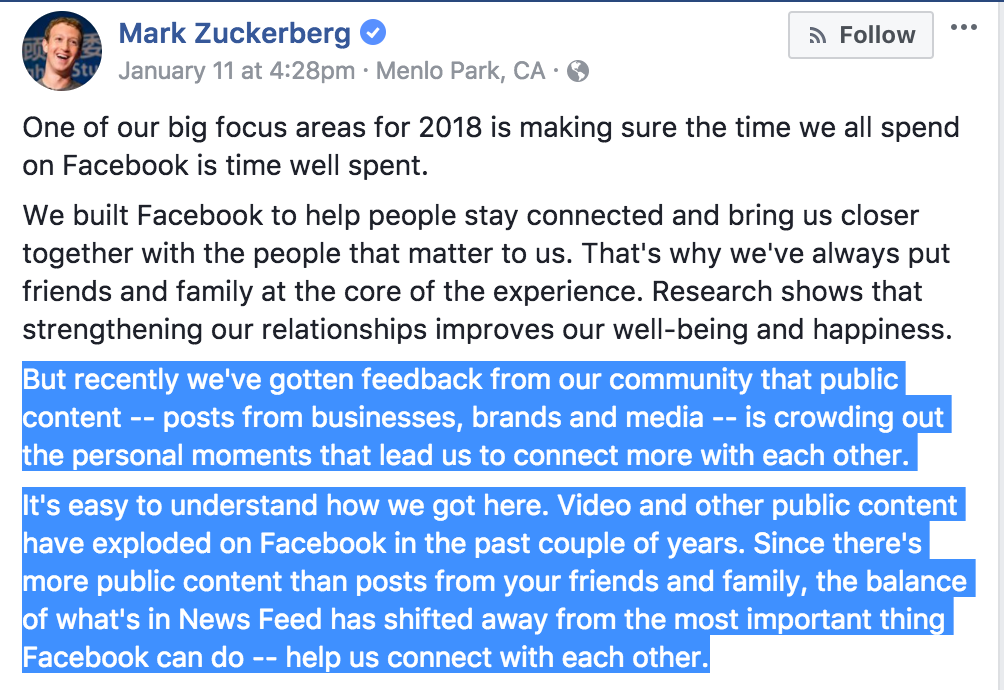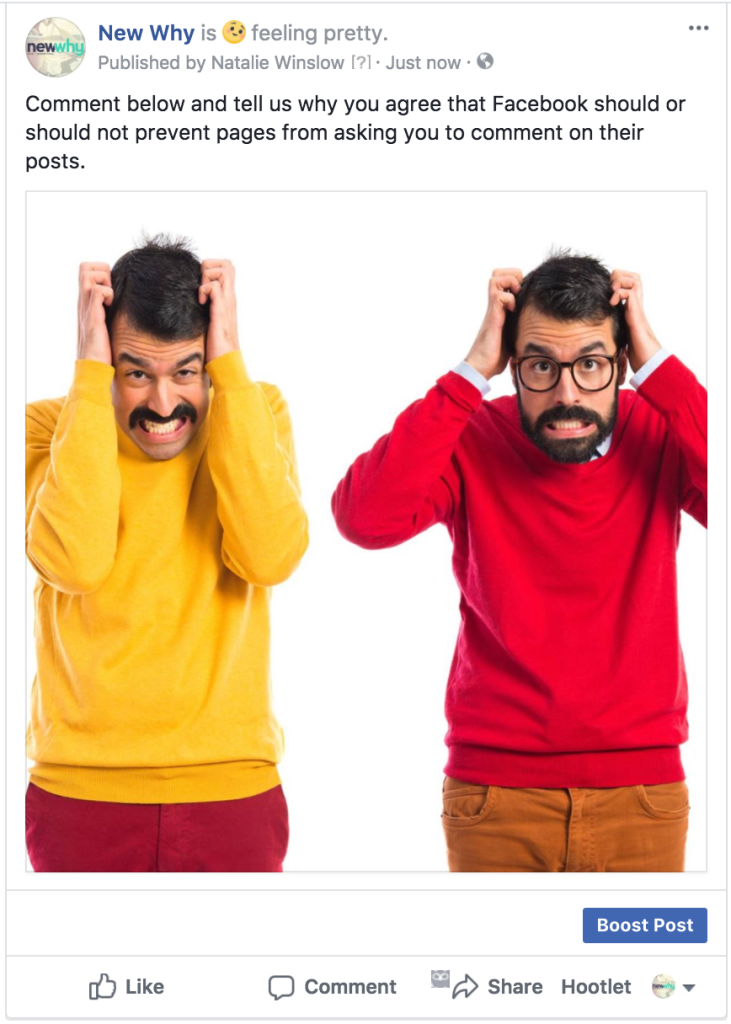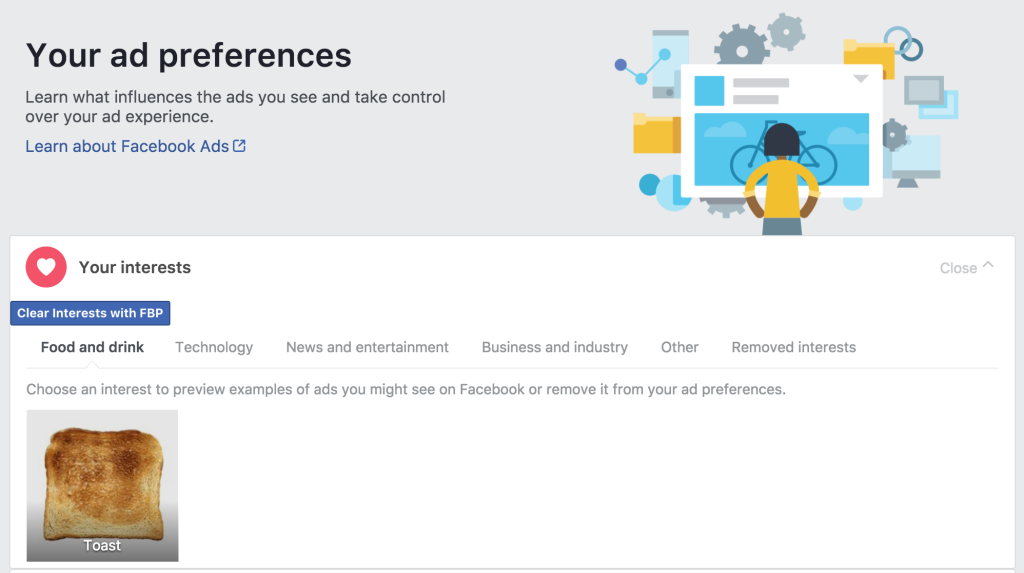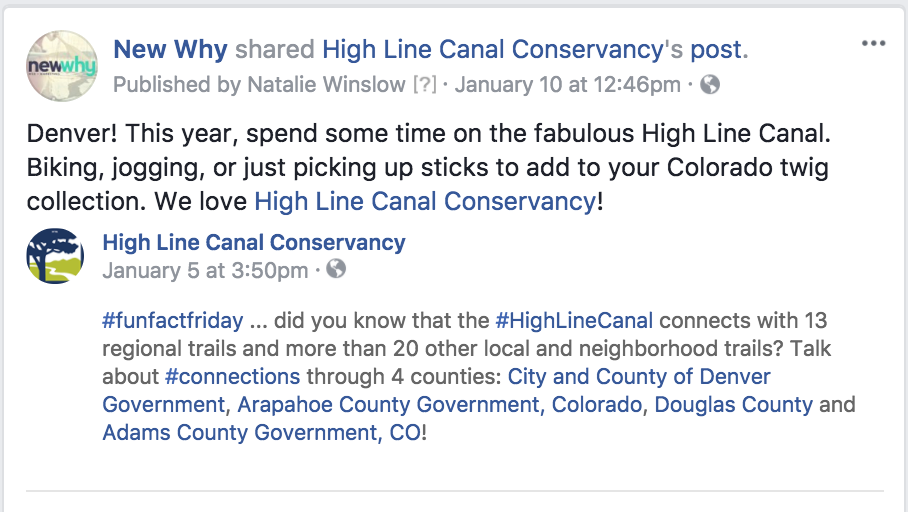Concrete Ways to Tackle Facebook’s Algorithm Update
For as long as I’ve been doing online marketing, the platforms have regularly changed to try and make more money their users happy. This is true of Google, when they began penalizing websites that relied on spammy tactics to get ranked higher; Google then began favoring websites with ethical SEO. And it’s true of Facebook as well. As more businesses began using Facebook, Facebook realized they could make more money by limiting businesses’ reach and then charging them to get it back more users felt overwhelmed with the sheer quantity of content, and Facebook is still trying to figure out how to make even more money the experience enjoyable again.
But enough passive aggressive commentary from me. The fact is, we’ve come to rely on Facebook to reach our communities, promote our services or products, and keep our businesses and organizations afloat. Yes, there are tons of tools aside from Facebook, but right now Facebook still holds a big chunk of our audience hostage for a pretty decent portion of their day (some would say 50 minutes). And as people who care about our businesses and organizations, we want to contribute to the Facebook conversation. We want to be part of that social circle. Our fans, volunteers, friends, customers, clients–they’ve followed us on Facebook because they want to hear from us. But Facebook isn’t convinced they actually do want to hear from us.
Facebook’s most recent algorithm update is summarized well in this post from Mark Zuckerberg:

Ok. Should we just give up on Facebook? Is it not worth it any more for businesses and nonprofits to use Facebook to inform, promote, and engage?
But that’s where our people are!
I don’t recommend abandoning Facebook just yet. Looking deeper into how the algorithm is going to work, here are a few ways we can try to keep our reach up, even if Facebook thinks we’re not as important as your weird great aunt you’ve only met once, who insisted on lecturing you on why you’d never get a job with your nose ring. Facebook, our fans like us better than they like their weird great aunt! I promise!
Here we go. My ideas and some tactics:
Get More Comments (But Without Facebook’s Algorithm Trigger Words)
“…the number of comments on a post will count more than the number of Likes, and it means that posts where people have taken the time to write long comments will get more weight than those with only short comments.”
– Jan. 11 article from Wired Magazine on Facebook’s new algorithm.
Not only do you need comments instead of likes, but you need long comments instead of short ones. Simple, you’re thinking. I’ll just post something like this, asking for my followers to comment on my post.

Sorry, New Why. WRONG. You know why you can’t simply ask your followers to comment? Here’s why:
“Facebook is cracking down on a new type of clickbait: Posts that ask people to “Like” or share or comment to goose engagement numbers, what Facebook is calling “engagement bait.”
– Dec. 18 article from Recode about Facebook’s algorithm.
Ok, so if I can’t ask people to comment, and “likes” won’t increase my reach the way they used to, then what can I do? The easy answer, which you will hear from a lot of marketing companies is “post great content that people want to comment on!” And to that I utter a big, resounding DUH. Of course. Of course we should be posting great content that people want to comment on. But you know what? You gotta start somewhere. Someone has to comment to get things moving along. And once they comment, then hopefully the reach of your post will spread and other people will comment too.
Let’s put aside all advice like “just be awesomer” and think about some real concrete tactics that don’t suck. Here are a few ideas I have on getting more comments on your posts, which will hopefully increase reach:
Get People in Your Organization to Comment

Note: if you work with French bulldogs they’re notoriously bad at Facebook. Cats are good at it, though.
Social media management should not be an isolated job in your organization. Everybody needs to help out a little, even if that means once a week, twice a week, every day (whatever!). And I’m not suggesting different people manage the social networks, I’m just suggesting that everyone in your organization who is on social should regularly comment on your page’s posts. I’ve written before about why everyone in your organization should blog, and the same holds true with social media. Everyone should comment at least once a week.
Ask for Comments on Other Networks

Monkeys don’t like social media, just FYI.
This is kind of a weird web I’m suggesting here, but I think it could work. Twitter doesn’t yet prohibit us from or penalize us for asking for comments. What if you post a link to your Facebook post in a tweet, asking people to comment and give feedback about the content? Don’t give away the entire content of your Facebook post on Twitter, or else people will be tempted to comment there. Get them back over to Facebook, and have them comment there. This will also help you populate Twitter with more content, since Twitter is an insatiable beast that consumes content like a black hole.
BONUS TIP FOR NONPROFITS: Ask Your Volunteers to Take a Commenting Shift

Volunteer commenters can do it from anywhere they want.
Nonprofits rely on volunteers to do so much, and this is an area that people will be excited to help with, in part because it is so easy. It doesn’t require them to donate money or even be anywhere. Let your volunteers know that taking the time to comment on one of your posts may help improve your reach, and improving your reach helps you get the word out to your community, your donors, and whoever else needs to learn about what you do. You can either create an official Facebook Commenting Volunteer group, or you can informally ask people to help out. I would experiment with both options because sometimes making it official helps people commit, and sometimes if it’s informal people will be more excited. Do both!
A Glimpse from the Dark Side: You Can Buy Comments

Do this at your own risk. The night is dark and full of terrors and/or a penalty from Facebook if they find out.
I’m not one to advocate for black hat SEO or unethical marketing tactics, but I will let you know that you can pay people to leave decent quality comments on your page. There are folks on Fiverr who will comment several times for just a few dollars, and if you’ve got a post that you really want people to see, you could try it. Shady? Kind of. Sure. I haven’t done it, and I’m not sure I would. But for scrappy organizations who just need a little boost, this is definitely an option. Over the years I’ve experimented with some of the dark arts of marketing only for my own organization, mostly out of curiosity and so I can tell my clients why these tactics do or don’t work (they usually don’t), but this isn’t one I’ve tried yet.
More Live Video
After telling brands to publish more and more videos by consistently showing video to more people than any other type of content, Facebook is now saying there’s too much video!
“There will be less video. Video is an important part of the ecosystem. It’s been consistently growing. But it’s more passive in nature. There’s less conversation on videos, particularly public videos.”
- Wired Magazine (see above)
Sigh. For so long I’ve been telling people to get on the video train because for so long its reach has been unbeatable. However, farther down in the Zuckerberg quote I posted above, there’s this line: “We’ve seen people interact way more around live videos than regular ones.” Does this mean that live video will continue to do well in our followers’ Facebook feeds? It’s possible.
Getting people to do live video is like pulling teeth, only more painful. Very few organizations, especially smaller ones, want to take the time to think about something to video live, and even if they do they’re terrified. Live video is a scary concept, but we’ve got to all get past the fear and embrace our weird, awkward selves. Maybe you’re not weird and awkward, but I am.
Here are some ideas for live videos:
Take a Quick Live Video At Every Event

Are you and your coworkers having a special meeting in the park? Do a quick live video! Just make sure to get the dog. Dog videos do great on Facebook.
Do you go to conferences, trainings, meetups, happy hours, political events, fundraisers, etc. and represent your organization in an official capacity there? If so, do a quick live video at every one of them. If there’s two of you at these, then one of you can film while the other narrates. It can be just a couple minutes of something fun to let your followers know what you’re up to. People want to see how your organization is involved in the world, and these videos can be a great snapshot into that.
Do a Live Video Interview of Someone in Your Organization Weekly

Pro tip: use a smartphone for these interviews, and not a 35mm camera from the 1970s.
Unless you’re a one-woman shop, which you might be, you can interview one person in your organization once a week for a live video. Yes, this person will be embarrassed and they will resist, probably, so give them a few questions ahead of time to think about so they are prepared and don’t feel caught off guard. This also lets your followers get to know your organization better, and it gives you material for weekly live videos.
Read Something Live

Mood lighting optional.
I actually really like this idea, if I do say so myself. Posting quotes to Facebook, Twitter, Instagram, LinkedIn, SnapChat, and wherever else you find yourself can be a good way to share with your audience themes that shape your business and life. But what if you take that a step further and actually read, on live video, from something that inspires you? This could be a poem, a page from a business book, part of an MLK speech, or a monologue from Buffy the Vampire Slayer. Whatever floats your boat. Your followers will get to see you and learn more about you. And you get immediate content ideas. You can do this once a week, and if you let your followers know that #MonologueMondays will be an ongoing thing, they’ll know to watch for it.
BONUS TIP FOR NONPROFITS: Feature Your Services and Talk About Volunteers, Donations, Etc. that Keep It Running

There’s always a story there.
Depending on what your nonprofit does, there are usually hundreds of ways to tell your story. Plan out how you would tell your story over the course of several short live videos. You could either tell a different story in each video, or you could use the videos to tell one overarching story. One video could be about how volunteers help. The other could be about the importance of donations. Another could be about how people benefit from your services, and you could interview members of the community you serve. There are so many options, just start by thinking about what’s important to keeping your organization running, and tell that story on video.
More Ad Money
Ah, the dreaded ad money. One of the problems with online marketing is that people think it should be free. So much of the internet and technology in general is invisible to people. We don’t see the time it takes to code a website, or the manual effort we put into things like keyword research, website audits, ad creation, community building. We don’t see that the “cloud” is actually a giant server farm located in an actual building somewhere, that every bit of data we put out there actually lives somewhere physical–somewhere that requires equipment and people. All those photos you post to Facebook? They take up actual space. And that space isn’t free. We want to push a button and have everything work for us, and we get upset when it doesn’t, and we don’t want to have to pay for it. It’s a weird thing, technology. It makes work invisible, for better or worse.
You probably know how Facebook makes money. But just in case, here’s a brief overview. They make money by selling all the information they know about me and you, based on what we do on Facebook and what we do off Facebook with Facebook’s cookie tracking us, to advertisers.

Facebook thinks I’m into toast, which is funny because I don’t even eat bread. Click on this image to find out what your ad preferences are.
They use this money to keep their server farms running, to pay their 23,000 employees who write and maintain the code and do all the legal stuff and businessy stuff for Facebook, to pay their contractors who spend hours combing through every single video uploaded to make sure they don’t contain graphic violence and/or exploitative content (can you imagine having that job?), and, most of all, to pay Mark Zuckerberg the $9 billion a year he makes through his ownership of Facebook stock.
That’s quite a money-gobbling machine we’ve got there, and we’re all feeding it all the time.
So, with that, let me propose that we give Zuckerberg even more money because $9 billion is frankly not enough. [insert eye roll]
I don’t have a list of ideas for this one, because ad money is ad money. Either you’ll spend it or you won’t, and this blog post is already getting too long for me to walk you through how to create Facebook ads. It’s something that we do for our clients, and if you’d like to talk more about it, please email me!
However, here is one way you can think about ads now that your organic reach might be lower.
Promote / Boost a Post Once a Month or Week

You don’t need tons of money. Try with a small budget and you might be surprised by the results.
Even if you can only spend $10 a month, choose a post that is really important for your followers and their friends to see. Whether it’s an announcement about an upcoming event, a job opening, a fundraiser you’re doing, a new product you’re launching, a poll you’re asking people to take, or any other type of content that helps your organization, put some money into it and see what happens. Usually when you boost a post, organic reach also grows.

It’s also easy to waste money on Facebook ads, so be sure you know what you’re doing. You can either read up on it, or hire someone like us to run Facebook ads for you.
BONUS TIP FOR EVERYONE: Create a Network within the Network
Many small business owners like myself work with other small business owners all the time. We help each other out with recommendations and introductions because running a small business is hard, and we know how important it is to support each other. The same goes for nonprofits. The needs of our communities are great, and nonprofits complement each other to cover as many areas as possible.
What if we take these networks that exist off of Facebook and try to formalize them as a Facebook sharing relationship? Agree to share something important on a regular basis from a business / nonprofit connection of yours in exchange for them sharing something of yours as well. We highly recommend sharing no matter what, but formalizing the relationship so that you both work to increase each other’s reach could be highly beneficial.

We share all the time because it feels good. Here’s a post from the wonderful High Line Canal we shared earlier this month.
You can create a network of three, four, five, however many you want, small businesses / nonprofits and agree that you will each share something monthly from the other, and that when you share that you will also use your internal resources to expand reach. Remember when I said above that your employees should be sharing your social content, too? Or that you can get volunteers to help share? Make it part of their job in this case to also share from the other organizations once a month.
This formalized arrangement builds your network, expands your reach, and strengthens your existing relationships. What more could you want?
Finitione
Facebook’s algorithm will change as long as Facebook is a thing. While some people (not naming names) are hoping for a digital apocalypse where the World Wide Web, with its tech tentacles all up in our business, collapses forever and we return to an agrarian or steam-punk-industrial utopia, I don’t see that happening any time soon. Businesses and nonprofits have other ways to promote our goods and services, but right now Facebook continues to be a platform where the people are. And we need to reach the people.
If you want help with your Facebook, learn more about our social media management services and social media for nonprofits. Or check out our other blog posts about social media.
Have something to say?